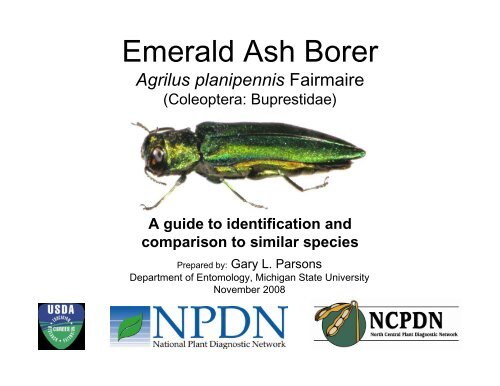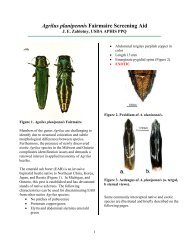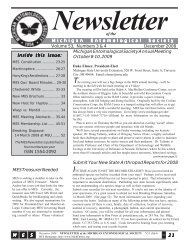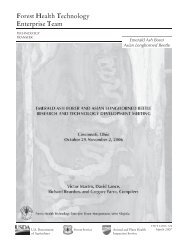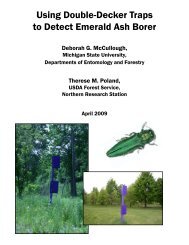Coleoptera: Buprestidae - Emerald Ash Borer
Coleoptera: Buprestidae - Emerald Ash Borer
Coleoptera: Buprestidae - Emerald Ash Borer
Create successful ePaper yourself
Turn your PDF publications into a flip-book with our unique Google optimized e-Paper software.
IntroductionThe adult stage of the <strong>Emerald</strong> <strong>Ash</strong> <strong>Borer</strong> (EAB) is fairly distinctiveand usually easy to tell apart from most similarly colored and shapedbuprestids and other insects by a trained taxonomist. However, manyresearchers and field workers currently sampling for EAB are nottrained taxonomists, and might confuse some other similarly shapedor colored insects with EAB. The species included in this guide werechosen because of their relative commonness, similarity in size,shape and/or coloration to the EAB, and because specimens wereavailable for photography in the A.J. Cook Arthropod ResearchCollection, at Michigan State University. Additional species, notincluded here, may be present in other parts of North America thatcould also potentially be confused with the EAB.
How to Use This GuideThis guide is intended to assist insect diagnosticians and otherswho have some familiarity in identifying insects. It’s use will beeasier if the user has at least a basic knowledge of insectmorphology and terminology and a basic familiarity with insectorders, families, and genera.
The main purpose of this guide is to assist with sight identification ofadult specimens that have been field collected or reared. It will besomewhat easier to verify the identity of beetles reared from knownhosts, however host data is not necessary to use this simple guide.Many trapping methods for EAB utilize Tanglefoot®, Pest-Stick® orsome other kind of sticky material. To be able to properly identifyspecimens, all residues of this sticky material must be removed with asuitable cleaning agent. Soaking beetles in 95% ethanol will dissolveTanglefoot, and Histoclear® will dissolve Pest-Stick. It may takeseveral days of soaking and frequent transfers to clean solvent toremove all traces of the sticky material. In addition, specimens inalcohol usually do not appear their true color or show setae and setalpatterns while wet. Ideally, specimens should be cleaned and allowedto air dry. Specimens mounted on pins or points will usually be mucheasier to manipulate under a dissecting microscope, which is usuallyneeded for best examination of these small beetles. The bright lightingtypically used with microscopy will best reflect the coloration of thesebeetles for comparison to the pictures used in the guide.
Note the similarity in color among the beetles in the photos to the left that wereremoved from sticky traps and pinned without any cleaning. The photos to theright are the same beetles after cleaning for only a few seconds with hexaneused as a solvent. While still not perfectly clean, sufficient color and patternsnow are evident to allow these to be identified to species.AgrilusanxiusAgrilusbilineatusAgriluscyanescens
The initial pages of this guide describe the general characteristics foridentification of the emerald ash borer. These are followed by pages showingsome additional species of Agrilus, other <strong>Buprestidae</strong>, and a few other beetlesthat have similar color and/or shape to the EAB, and which could potentiallybe confused with it.These pages can be used for basic sight comparison and possibleidentification of some of the more common species in question. This guideuses coloration differences and a few distinctive, morphological characters forcomparisons. Those using this guide should not expect to be able to identifyany given specimen with absolute certainty to the species level. There are171 species of Agrilus in North America, and only a few representatives areshown here. Many of the smaller species are very similar to each other, andmost can only be reliably identified with keys. There are a few keys for NorthAmerican Agrilus (Fisher 1928, Bright 1987, Downie & Arnett 1996 for eastern species) andother <strong>Buprestidae</strong> that can be used for identification of difficult specimens.However, it may still be necessary to send difficult specimens to an expertwith familiarity in this group of insects. There are currently no revised keysavailable to North American Agrilus or other <strong>Buprestidae</strong> that include theEAB.
An example of a species comparison to EABas used in this guide1. Scientific and common name(if available) of the speciesbeing compared to EAB.2. Side-by-side comparison ofthe species to EAB at thesame size scale.3. Text box listing size range,description of color and shape,similarities and differences toEAB, and known host plants.4. Side, top and oblique views ofthe species showing color andshape characteristics.5. Photos of the most diagnosticcharacteristics that will aid inseparation of the species fromEAB.6. Range map of the species.1 Agrilus bilineatus (Weber) 2“two-lined chestnut borer”• Length: 4.2-9.5 mm, slightly smaller than EAB.• Distinctively colored bronze-black with whiteyellowpubescent stripes extending from3edges of pronotum backwards along length ofelytra (only visible on dry specimens).• Abdominal dorsum black in color (red in EAB),pygidium with carina and projecting spine(similar to EAB).• Hosts: oaks, chestnut, American hornbeam,beech, and eastern hop hornbeam.bilineatus withcarina/spine dorsumof abdomen black5EAB withcarina/spine dorsumof abdomen redSource of morphological characteristics, host records anddistributional data primarily from Bright 1987, Downie & Arnett1996, and Fisher 1928.64
Family: <strong>Buprestidae</strong> “metallic wood-boring beetles”The genus Agrilus is one of 53 genera of <strong>Buprestidae</strong> found in North America.Fortunately, species in the genus Agrilus have a very distinctive shape that willeasily separate them from most of the other common genera of <strong>Buprestidae</strong>.Agrilus in general are more linear and cylindrical than other genera of <strong>Buprestidae</strong>and the base of the prothorax is produced backward as a lobe, which is lacking orless obvious in most other genera (except Brachys and Chrysobothris).Pronotum in Agrilusproduced backward aslobeAcmaeodera Anthaxia Brachys Buprestis ChalcophoraAgrilus are moreelongate and cylindricalthan other <strong>Buprestidae</strong>Agrilus (EAB)Note: specimensare not all to thesame size scaleChrysobothris Chrysophana Cypriacis Dicerca Melanophila/Phaenops
Identification of the<strong>Emerald</strong> <strong>Ash</strong> <strong>Borer</strong>
Agrilus planipennis Fairmaire“emerald ash borer” (EAB)• Typical specimens are a bright, metallic, emeraldgreen color overall, with the elytra usuallyappearing somewhat duller and slightly darkergreen. The overall greenish coloration may also havevariable amounts of brassy, coppery or reddishreflections, especially on the pronotum and ventralsurfaces.• A few rare specimens of EAB are entirely copperyred,entirely bluish-green, or green with bluish elytra.• Length:
emerald ash borer (continued)• In EAB the dorsal surface of theabdomen is bright coppery-red.This may only be visible if theelytra and wings are raised.• EAB is the only Agrilus speciesfound in North America that has thedorsal surface of the abdomen brightmetallic red. This may be the simplestdiagnostic character for separating EABfrom all other Agrilus in North America.• The dorsum of the abdomen is normallyblack, green or blue on all other NorthAmerican species of Agrilus .• Note: The hind wings on many Agrilus speciesoften have a reddish or pinkish iridescence thatmay be visible on the folded wings if the elytraare not completely closed. This may give theimpression of a reddish abdomen when in factit is only the hind wings that reflect this color.The only reliable way to determine the dorsalabdominal color is by spreading apart the elytraand hind wings to view the dorsum of theabdomen from above.upper sideof abdomencoppery-redin EABAgrilus bilineatus – the dorsumof the abdomen is actuallyblack in this species, but thefolded hind wings show areddish iridescence whichmakes it appear that theabdomen beneath the wings isreddish.
emerald ash borer (continued)• A longitudinal, mid-dorsal carina (ridge) ispresent on the pygidium (last dorsal abdominalsegment), with the carina projecting beyondthe tip of the abdomen as a blunt, slightlynotched “spine” (this usually can be seen frombehind even with the elytra closed) .• Note: Many other species of Agrilus may also have apygidial carina with or without a projecting terminalspine, but these normally do not have the abdomen reddorsally.pygidiumcarinaprojecting spine of carina
emerald ash borer (continued)• In EAB the antennal segments are serrate beginning with segment 4.(segments 1-3 cylindrical, segments 4-11 are triangular or “saw-like”).• Note: Many species of Agrilus have the antennae serrate beginning with segment 4. However, insome species the antennae are serrate beginning with segment 5 (1-4 cylindrical).56…Segments 4-11 serrate(triangular, saw-like)1234Segments 1-3 cylindrical
emerald ash borer (continued)Almost all Agrilus species exhibit some degree of natural variation in size andcoloration. This is especially so with metallic colored species.The specimens below show some of the size range and color variation seen in the moretypical specimens of EAB.It should be noted that “metallic” coloration can be influenced by light intensity, light direction, and lightquality. As you move metallic specimens around under a light, you can see them apparently change orshift color. Therefore, it is possible that individual specimens in hand may not exactly match the photosused in this guide. The individual species descriptions in this guide try to describe some of the colorvariations but odd variants often occur. As noted earlier, specimens in alcohol or covered in sticky trapmaterial will seldom reflect their true colors and should be cleaned and dried before comparison to thephotos in this guide.
emerald ash borer (continued)Some examples of non-typically colored EAB adults.green with bluish elytraentirely bluish(Note: dorsal surface of abdomen of some bluish specimens is brassy-green with only a slight reddish tinge)entirely red, purplish-red or coppery-redAlthough these color varieties are very rare, they might easily be confusedfor some of our native species which are similarly colored.
emerald ash borer (continued)EAB was accidentally introduced into southeastern Michigansometime in the 1990’s in wood packing material imported fromeastern Asia. It wasn’t until 2002 that EAB was first recognized asbeing the source of ash tree deaths and its identity confirmed, bywhich time it had apparently become well established. Since then,EAB has been found in many parts of Michigan and most nearbystates and Canada. The beetles are easily transported in dead ashlogs and firewood, and despite quarantines on wood movement, thismethod of dispersal seems partly or mostly responsible for theirrapid spread. It is possible EAB might eventually spread to anywherein North America where suitable ash hosts are found. Research isbeing conducted to find effective chemical and biological controlmethods, but even then, it is unlikely that EAB can be completelyeradicated, and it will likely continue invading some other parts ofNorth America. Go to http//:www.emeraldashborer.info for currentdistributions and other up-to-date information on the EAB.
Distribution of <strong>Ash</strong> (Fraxinus spp.)As many as 21 species of ash(Fraxinus spp.) are distributedthroughout much of the UnitedStates. EAB is known to feed onthe 4 major ash species found inthe northeast U.S., but whether itwill feed on other ash species orbe able to adapt to other areas inthe U.S. is not well known at thistime. However, this guide doesinclude some beetle species fromthe western and southeasternU.S. for comparison purposes incase it eventually invades thoseareas.Approximate distribution of Fraxinusspecies in North America
Other species of AgrilusFollowing are 20 species of Agrilus that are common in eastern andmidwestern North America, with a few from the southwestern U.S. Many ofthese species have already been collected on the various types of traps beingused for monitoring EAB. Only one other species of Agrilus, A. subcinctus, haspreviously been recorded as attacking ash (Fraxinus spp.) in North America. Itis a very small species that most likely only attacks small dead twigs and isdistinctly different in appearance from EAB. While other native species ofAgrilus have not been recorded as attacking living or dead ash, for somespecies the hosts are poorly known or unknown. It is also possible that manyother Agrilus species might be found incidentally resting on ash foliage ortrunks, or emerging from undetermined species of dead trees, logs andfirewood that might be monitored for EAB. In the following pages, some ofthese additional Agrilus species are compared to EAB, with some simplefeatures highlighted that can be used to distinguish them from EAB. Many ofthese Agrilus species are usually considerably smaller than EAB and should bedistinguishable on size alone. Those species that fall within the size range ofEAB can usually be distinguished on coloration differences.
Agrilus species compared to EAB in this guideSpecies similar in size to EAB ( > 8.5 mm ) Species usually smaller than EAB ( < 8.5 mm )AgrilusacutipennisAgrilusanxiusAgrilusarizonicusAgrilusbilineatusAgrilusdifficilisAgrilusarcuatusAgriluscrataegiAgriluscuprescensEABAgriluscyanescensAgriluslacustrisAgrilusmasculinusAgrilusliragusAgrilusmacerAgrilusnigricansAgrilussapindiAgrilusvittaticollisNote: all specimens are to same size scaleAgrilusobsoletoguttatusAgriluspolitusAgrilusruficollisAgrilussubcinctus
Agrilus species similar in size to EAB(> 8.5 mm.)Some species included here may have a size range whichincludes individuals whose size is less than 8.5 mm, but in whichthe largest individuals approach the size of EAB. The size rangeof EAB is listed as 10.0-13.0 mm, but individuals of EAB rearedfrom cut logs can be highly variable in size and it is expected thatsome rare individuals might be smaller or even larger.
Agrilus acutipennis Mannerheim• Length: 7.5-10.0 mm, silghtly smaller than EAB• Color black with faint bluish or greenishreflections, sometimes brilliant blue.• Sides of abdomen and thorax often withpatches of whitish setae (ABSENT in EAB).• Abdominal dorsum black in color (RED in EAB).• Pygidium with carina and projecting terminalspine (similar to EAB).• Hosts: larval host unknown. Adults havebeen collected on oak (Quercus spp.), birch(Betula spp.), poplar (Populus spp.), andAmerican hazel (Corylus americana).acutipennisEABacutipennis with white setosepatches on side of abdomen
Agrilus anxius Gory“bronze birch borer”• Length: 5.5-13.0 mm, similar in size to EAB.• Color bronze-black with faint reddish,greenish, or purplish reflections.• Abdominal dorsum bronze-black in color(RED in EAB).• Pygidium with carina and projecting terminalspine (similar to EAB).• Pronotum with distinct prehumeral carina(ABSENT in EAB).• Hosts: birch (Betula spp.), often attacking anddamaging living trees.anxiusEABanxius withdistinctprehumeralcarina onpronotum
Agrilus arizonicus Obenberger• Length: 9.0 mm, slightly smaller in size thanEAB.• Color bright green, with brassy reflections,extremely similar in coloration to the EAB.• Abdominal dorsum greenish-black in color(RED in EAB).• Pygidium with faint carina but without projectingterminal spine (PROJECTING in EAB).• Antennae serrate beginning with segment 5(vs. segment 4 in EAB).• Hosts: unknownarizonicusEABarizonicus pygidiumwithout projectingspine, dorsum ofabdomen blackEAB pygidium withprojecting spine, dorsumof abdomen red
Agrilus bilineatus (Weber)“two-lined chestnut borer”• Length: 4.2-9.5 mm, slightly smaller then EAB.• Distinctively colored bronze-black with whiteyellowpubescent stripes extending from edgesof pronotum backwards along length of elytra(only visible on dry specimens – ABSENT in EAB).• Abdominal dorsum bronze-black in color(RED in EAB).• Pygidium with carina and projecting terminalspine (similar to EAB).• Hosts: oaks (Quercus spp.), chestnut (Castanea dentata),American hornbeam (Carpinus caroliniana), beech (Fagusspp.), and eastern hop hornbeam (Ostrya virginiana).bilineatusEABbilineatus with carina/spinedorsum of abdomen blackEAB with carina/spinedorsum of abdomen redbilineatus with dorsalpubescent stripes
Agrilus difficilis Gory• Length: 7.0-13.0 mm, equal in size to EAB.• Color greenish-black with a purplish reflection,coppery below with dense yellow setosepatches laterally on metathorax and abdominalsegments (ABSENT in EAB).• Abdominal dorsum coppery-black in color(RED in EAB).• Pygidium with carina but without projectingterminal spine (PROJECTING in EAB).• Pronotum with arcuate, obtusely roundedprehumeral carina (ABSENT in EAB).• Hosts: honeylocust (Gleditsia triacanthos) andsouthern prickly ash (Zanthoxylum clavaherculis).Adults collected from willow (Salix spp.).difficilisEABdifficilis with dense yellowsetose patches laterally
Agrilus liragus Barter & Brown“bronze poplar borer”• Length: 7.0-11.0 mm, slightly smaller than EAB(Note: liragus is very similar to A. anxius and difficult toseparate from that species except by hosts).• Color bronze-black with faint coppery,greenish, or purplish reflections.• Abdominal dorsum bronze-black in color(RED in EAB).• Pygidium with carina and projecting terminalspine (similar to EAB).• Pronotum with obtusely rounded prehumeralcarina (ABSENT in EAB).• Hosts: poplar and aspen (Populus spp.)liragusEABliragus withdistinctprehumeralcarina onpronotum
Agrilus macer LeConte• Length: 8.5-16 mm, equal or larger in size to EAB.• Color coppery-brown with faint bronze or olivegreenreflections. Dense yellow setose patches onfront of head, sides of pronotum and abdomen.• Abdominal dorsum brownish-black in color(RED in EAB).• Pygidium with carina and projecting terminalspine (similar to EAB).• Pronotum with distinct prehumeral carina(ABSENT in EAB) (see Agrilus anxius for photo).• Each elytron with a distinct longitudinal carina(ABSENT in EAB).• Hosts: hackberry (Celtis spp.).macerEABmacer with longitudinal carinaon each elytron
Agrilus nigricans Gory• Length: 7.7-12.0 mm, equal in size to EAB.• Color black or brown with a vague greenishreflection, green or brassy below with sparseyellow setose patches laterally on theprothorax, metathorax and abdominalsegments.• Abdominal dorsum black in color (RED in EAB).• Pygidium with carina and projecting terminalspine (similar to EAB).• Pronotum without prehumeral carina(also absent in EAB).• Hosts: larval host unknown. Adults collectedon red oak (Quercus rubra).nigricansEABnigricans with sparse yellowsetose patches laterally
Agrilus vittaticollis (Randall)• Length: 8.0-9.7 mm, slightly smaller then EAB.• Distinctively colored, head and pronotumpurplish-red, with brassy tinge and two darklongitudinal stripes, elytra black. Head,pronotum and sides of abdomen with denserecumbent, golden-yellow setae.• Abdominal dorsum black in color (RED in EAB).• Pygidium with carina and projecting terminalspine (similar to EAB).• Hosts: serviceberry (Amelanchier canadensis),hawthorn (Crataegus spp.), apple, pear, wildcherry (Pyrus spp. and Malus spp.), and chokecherry(Prunus virginiana).vittaticollisEABdistinctivecoloration ofvittaticollisseparates itfrom mostother Agrilus
Agrilus species much smaller than EAB(< 8.5 mm.)Most of the species included here will normally bemuch smaller than any known EAB individuals. Inmost cases they should be distinguishable fromEAB on size alone.
Agrilus arcuatus (Say)• Length: 6.0-7.5 mm, much smaller than EAB.• Color of head and pronotum coppery-brown tobronzy-green, elytra blackish with coppery orbrassy reflection.• Abdominal dorsum black in color (RED in EAB).• Pygidium with dorsal carina but withoutprojecting terminal spine (PROJECTING in EAB).• Pronotum with distinct prehumeral carina(ABSENT in EAB) (see Agrilus anxius for photo).• Hosts: black oak (Quercus velutina), white oak (Q. alba),beech (Fagus americana), American chestnut (Castaneadentata), American hazel (Corylus americana), and hickory(Carya spp.).arcuatusEABarcuatus color and size variation
Agrilus crataegi Frost• Length: 6.0-8.0 mm, much smaller than EAB.• Color greenish-bronze with copperyreflection, elytra more distinctly coppery-redon apical third, appearing bicolored.• Abdominal dorsum black in color (RED in EAB).• Pygidium with faint dorsal carina but withoutprojecting terminal spine (PROJECTING in EAB).• Pronotum with distinct prehumeral carina(ABSENT in EAB) (see Agrilus anxius for photo).• Host: hawthorn (Crataegus spp.)crataegiEABcrataegielytra“bi-colored”with apicalthird morebrightlycoppery-red
Agrilus cuprescens (Menetries)“rose stem girdler”• Length: 4.0-6.3 mm, much smaller than EAB.• Color greenish-bronze with coppery-red tobrassy-green reflections.• Abdominal dorsum bronze-black in color(RED in EAB).• Pygidium with faint dorsal carina but withoutprojecting terminal spine (PROJECTING in EAB).• Pronotum with distinct prehumeral carina(ABSENT in EAB) (see Agrilus anxius for photo).• Hosts: rose (Rosa spp.), current (Ribes spp.),raspberry and blackberry (Rubus spp.).cuprescensEABcuprescensbrassy-green color formIntroducedfrom Europe
Agrilus cyanescens (Ratzeburg)• Length: 5.5-6.25 mm, much smaller than EAB.• Color uniformly dark blue to greenish-blue above,ventrally black to bluish-black.• Abdominal dorsum bluish-black in color (RED in EAB).• Pygidium with dorsal carina but withoutprojecting terminal spine (PROJECTING in EAB).• Pronotum with elongate, obtuse prehumeralelevation instead of a carina (ABSENT in EAB).• Hosts: honeysuckle (Lonicera spp.). In Europe, alsoreported from oak (Quercus spp.), birch (Betula spp.),beech (Fagus spp.) , alder (Alnus spp.) and rose (Rosa spp.) .cyanescensEABcyanescenswithprehumeralobtuseelevationIntroducedfrom Europe
Agrilus lacustris LeConte• Length: 4.0-7.5 mm, much smaller than EAB.• Color uniformly dark bronzy-brown togreenish-bronze or bluish-bronze.• Abdominal dorsum bluish-black in color(RED in EAB).• Pygidium with faint dorsal carina but withoutprojecting terminal spine (PROJECTING in EAB).• Pronotum with weak or indistinct prehumeralcarina (ABSENT in EAB).• Host: croton (Croton spp.).lacustrisEABlacustris color and size variation,similar in color to EAB but muchsmaller
Agrilus masculinus Horn• Length: 4.0-6.5 mm, much smaller than EAB.• Color bronzy-green, elytra black with bronzyreflection.• Abdominal dorsum greenish-black in color(RED in EAB).• Pygidium with faint dorsal carina but withoutprojecting terminal spine (PROJECTING in EAB).• Pronotum with distinct prehumeral carina(ABSENT in EAB).• Hosts: boxelder (Acer negundo), red maple (Acerrubrum), and Ohio buckeye (Aesculus glabra).masculinusEABmasculinuswithprehumeralcarina onpronotumNote: red under elytra in photo above isreflection from hind wing, not abdomen
Agrilus obsoletoguttatus Gory• Length: 4.7-8.0 mm, much smaller than EAB.• Color bronzy-black to greenish-brown,sometimes with weak purplish reflections, 3-4patches of sparse, recumbent, yellow setae onelytra and sides of abdomen (ABSENT in EAB).• Abdominal dorsum black in color (RED in EAB).• Pygidium with faint dorsal carina but withoutprojecting terminal spine (PROJECTING in EAB).• Pronotum with distinct prehumeral carina(ABSENT in EAB).• Hosts: American beech (Fagus grandifolia) , Americanhornbeam (Carpinus caroliniana), eastern hop hornbeam(Ostrya virginiana), red oak (Quercus rubra), hickory (Hickoriaspp.) and birch (Betula spp.)obsoletoguttatusEABobsoletoguttatus with setose patches on elytra
Agrilus politus (Say)• Length: 4.7-8.5 mm, much smaller than EAB.• Color coppery-red or green to bluish-greenor leaden.• Abdominal dorsum black in color (RED in EAB).• Pygidium with faint dorsal carina but withoutprojecting terminal spine (PRESENT in EAB).• Pronotum with distinct prehumeral carina(ABSENT in EAB) (see Agrilus anxius for photo).• Hosts: maple (Acer spp.), and willow (Salix spp.).politusEABpolitus with faint pygidial carina but withoutprojecting spine, dorsum of abdomen black
Agrilus ruficollis (Fabricius)“raspberry cane borer”• Length: 4.0-7.0 mm, much smaller than EAB.• Distinctly bi-colored, color of head andpronotum coppery or brassy, elytra andventral surfaces black.• Abdominal dorsum black in color (RED in EAB).• Pygidium with dorsal carina and projectingterminal spine (similar to EAB).• Pronotum without distinct prehumeral carina(also absent in EAB)• Hosts: raspberry and blackberry (Rubus spp.).ruficollisEABruficollisdistinctlybi-colored
Agrilus sapindi Knull• Length: 8.5, slightly smaller than EAB.• Color brassy or bronzy-green, with whitesetose patches along sides of abdomen.• Abdominal dorsum black in color (RED in EAB).• Pygidium with faint dorsal carina but withoutprojecting terminal spine (PROJECTING in EAB).• Pronotum without prehumeral carina (alsoabsent in EAB).• Hosts: unknown.sapindiEABsapindi with sparse whitesetose patches laterally,no terminal spine
Agrilus subcinctus Gory• Length: 3.5-4.5 mm, very much smaller than EAB.• Color black with strong brassy or copperyreflections, elytra ornamented with whitishpubescent designs.• Abdominal dorsum black in color (RED in EAB)• Pygidium without dorsal carina or projectingterminal spine (PRESENT in EAB).• Hosts: breeds in ash (Fraxinus pennsylvanicus var.lanceolata); recorded from privet (Ligustrum spp.)and foliage of poison ivy (Toxicodendron spp.).• This is the only native species of Agrilusrecorded as breeding in ash.subcinctusEABsubcinctus with white pubescentpatches forming patterns on elytra
Some additional species compared to EAB in this guideChrysobothrisharrisii(BUPRESTIDAE)Chrysophanaplacida(BUPRESTIDAE)Cypriacisaurulenta &C. striata(BUPRESTIDAE)Cypriacisfasciatus(BUPRESTIDAE)Cypriacislangii(BUPRESTIDAE)Anthaxiadeleta(BUPRESTIDAE)Anthaxiaquercata(BUPRESTIDAE)EABNote: all specimens areto same size scaleBuprestissalisburyensis(BUPRESTIDAE)Cteniceraresplendens(ELATERIDAE)Temnoscheilavirescens(TROGOSSITIDAE)
Other Genera of <strong>Buprestidae</strong>Many species included in other genera of <strong>Buprestidae</strong> in North Americaare colored bright green. They can usually be separated easily fromEAB by size and shape, being much flatter, wider and much larger orsmaller in size than the EAB and other Agrilus species. Only a few ofthe most commonly seen green-colored species are included in thisguide.
Anthaxia deleta LeConte• Length: 4.0-6.3 mm, much smaller than EAB.• Color bright metallic green with faint bluishreflections on elytra.• Body wider and flatter than EAB. Pronotumnot produced backward as lobe (LOBED in EAB).• Hosts: willow (Salix spp.), water birch (Betulaoccidentalis), dogwood (Cornus spp.), and alder(Alnus spp.). Also reported from various conifers.deletaEABAnthaxiapronotum NOTlobed behindEABpronotumlobed behind
Anthaxia quercata (Fabricius)• Length: 3.8-5.3 mm, much smaller than EAB.• Color bright green or bluish, with a bronzespot centrally on the pronotum and bronzestripes laterally on the margin of each elytron.• Body broader and flatter than EAB. Pronotumnot produced backward as lobe (LOBED in EAB)• Hosts: redbud (Cerceris spp.), hawthorn (Crataegus spp.),hickory (Carya spp.), plum (Prunus spp.) oak (Quercus spp.),grape (Vitis spp.), tamarack (Larix laricina) , and pine(Pinus spp.). Probably many other hardwoods andconifers.quercataEABAnthaxiapronotum NOTlobed behindEABpronotumlobed behind
Chrysophana placida (LeConte)• Length: 6.0-10.5 mm, usually smaller than EAB.• Color bluish or greenish, pronotum with acoppery spot at middle front, each elytron with abroad, coppery-red, longitudinal stripe.• Body broader and flatter than EAB. Pronotumnot produced backward as lobe (lobed in EAB).• Hosts: pine (Pinus spp.), hemlock (Tsuga spp.), fir(Abies spp.), Douglas-fir (Pseudotsuga menziesii), andwestern red cedar (Thuja plicata).placidaEABplacidawith redstripeson broadelytra
Chrysobothris harrisi (Hentz)• Length: 6.5-9.0 mm, slightly smaller than EAB.• Color dark green, with bluish reflections.• Body much broader and flatter than EAB.Pronotum produced backward as lobe(similar to EAB).• Head with longitudinal carina on vertex(vertex of EAB sunken).• Hosts: pine (Pinus spp.).harrisiEABChrysobothriswith carina onvertex of headEAB vertex ofhead sunken
Buprestis salisburyensis Herbst• Length: 10-15 mm, slightly larger than EAB.• Color bluish-green with the lateral margins of thepronotum and lateral and sutural margins of theelytra bright coppery red. Ventral surface brightcoppery.• Body broader and flatter than EAB. Pronotumnot produced backward as lobe (LOBED in EAB).• Elytra with distinct rows of large puncture(NO large punctures in EAB).• Hosts: pine (Pinus spp.).salisburyensisEABsalisburyensiselytra withrows of largepuncturesEABelytrawithoutlargepunctures
Cypriacis aurulenta (Linnaeus)• Length: 13-22 mm, much larger than EAB.• Color bright green with brassy and bluishreflections; head, lateral margins of pronotum,sutural and lateral margins of elytra coppery-red.• Body broader and flatter than EAB. Pronotumnot produced backward as lobe (LOBED in EAB).• Disc of each elytron with 5 strongly elevated,smooth costae (NO costae in EAB).• Hosts: fir (Abies spp.), pine (Pinus spp.), Douglas-fir(Pseudotsuga menziesii) and western redcedar (Thujaplicata).aurulentaEABaurulentaelytra withdistinct costae,sutural andlateral marginscoppery-red
Cypriacis fasciatus (Fabricius)• Length: 11-18 mm, much larger than EAB.• Color bright green to blackish-green with faintbluish reflections, elytra with distinct yellowmarkings near apex.• Body broader and flatter than EAB. Pronotumnot produced backward as lobe (LOBED in EAB).• Elytra striate, with apices bidentate (NO striae inEAB, apices rounded).• Hosts: uncertain records for pine (Pinus spp.),maple (Acer spp.), poplar (Populus spp.) and oak(Quercus spp.).fasciatusEABfasciatuselytra withdistinct striae,yellow markings,apices bidentate
Cypriacis langii (Mannerheim)• Length: 13-21 mm, much larger than EAB.• Color bright green or blue-green with faintbrassy reflections. Some specimens withindistinct yellow to tan spots on the elytra.• Body broader and flatter than EAB. Pronotumnot produced backward as lobe (LOBED in EAB).• Elytra distinctly costate (NO costae in EAB).• Hosts: Douglas-fir (Pseudotsuga menziesii). Adultsfound on foliage of willow (Salix spp.) and alder(Alnus spp.).langiiEABlangiielytra withcostaeEABelytrawithoutcostae
Cypriacis striata (Fabricius)• Length: 13-22 mm, much larger than EAB.• Color bright green with coppery reflections,elytra bluish on discs; head, lateral margins ofpronotum, sutural and lateral margins of elytrabrilliant coppery (very similar to western C. aurulenta).• Body broader and flatter than EAB. Pronotumnot produced backward as lobe (LOBED in EAB).• Disc of each elytron with 5 weakly elevated.punctate costae (NO costae in EAB).• Hosts: pine (Pinus spp.), eastern hemlock (Tsugacanadensis), spruce (Picea spp.), and larch (Larix spp.).striataEABstriataelytra withweak costae,sutural andlateral marginscoppery-red,disc bluish
Some other Families of beetlesMany members of other families of beetles are also colored bright green.Green-colored species can be found in Carabidae, Cerambycidae,Chrysomelidae, Scarabaeidae, and others. These can usually be easilydistinguished from EAB and other <strong>Buprestidae</strong> by size, shape and othercharacteristics. Most “click beetles” (Family: Elateridae) have the samegeneral shape as <strong>Buprestidae</strong>, however, most are also dull colored. Asingle widely-distributed, metallic-colored species is included in this guide.“Bark-gnawing beetles” (Family: Trogossitidae) include many species thatdo not resemble <strong>Buprestidae</strong>. However, the common genus Temnoscheila,includes 5 species that are metallic green or blue, similarly shaped to EAB,and are commonly found under bark of decaying logs. The most commoneastern species of this genus has also been included in this guide. Whilethe difference between most of these other green beetles and EAB mayseem obvious to diagnosticians and taxonomists, to many others “a bug isa bug” and to them, all these insects may look remarkably similar. This reenforcesthe need to have all suspected sightings and reports confirmedby experts in identification.
Family: Elateridae “click beetles”Ctenicera resplendens (Eschscholtz)• Length: 10-15 mm, slightly larger than EAB.• Color bright green with brassy and copperyreflections.• Pronotum “hinged” to mesothorax withventral click mechanism, and hind anglesprolonged backward as sharp spines(all ABSENT in EAB).• Hosts: unknown, but other elaterids feed onherbaceous plant roots, in rotting wood orare predators.resplendensEABresplendensprothorax hingedto mesothorax,hind anglesprolonged asspines?
Family: Trogossitidae “bark-gnawing beetles”Temnoscheila virescens (Fabricius)• Length: 8.6-17.8 mm, slightly larger than EAB.• Color bright green or blue-green varying to almostdark purplish-blue, often with brassy reflections.• Head large, prognathous, and more evident thanin <strong>Buprestidae</strong>, and the connection of thepronotum to mesothorax is narrowed, waist-like.• T. virescens occurs in the eastern U.S. with T.chlorodia (Mannerhiem), a very similar species,occurring in the western North America. Bothspecies are predators found under the bark ofdead trees where they feed on a variety of woodboringbeetles.virescenspronotumconnected tomesothorax bya narrow waistvirescensEABT. chlorodiaT. virescens
References• Bright, D. 1987. The metallic wood-boring beetles of Canada andAlaska. <strong>Coleoptera</strong>: <strong>Buprestidae</strong>. The Insects and Arachnids of Canada,Part 15. Minister of Supply and Services. Ottawa, Canada. 335 pp.• Brockman, C.F. 1968. Trees of North America, a field guide to themajor native and introduced species North of Mexico. Golden Press,New York, N.Y. 280 pp.• Downie, N.M. and R.H. Arnett. 1996. The Beetles of NortheasternNorth America (in 2 volumes). Sandhill Crane Press, Gainesville,Florida. 1721 pp.• Fisher, W.S. 1928. A revision of the North American species ofBuprestid beetles belonging to the genus Agrilus. United States NationalMuseum Bulletin, 145: 1-347• Zablotny, J.E., 2006. Agrilus planipennis Fairmaire Screening Aid.USDA, APHIS PPQ. http://www.emeraldashborer.info/files/agriscrn.pdf• All photos by Gary L. Parsons 2006, 2007, 2008


